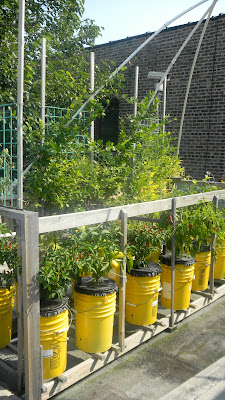Look at all the roots at the bottom of this top bucket. Should they be freezing and then decomposing come spring? We reserve a bin for all this vegetative matter, load it up, and send it down to the compost heap.
Drying out the mix is a quiet practice done over time, but worth it for the health of the mix and next year's plants. We also rotate the potting mix so the same plants aren't growing in it the following year. If you're not growing on a roof (or even if you are), there are many ways to accomplish the same idea we show here.
By the way, earthbox instructions say you can plant and replant the following year without removing the mix. As you'll note from these photos, that's not possible with the smaller 5-gal SIPs. Roots end up occupying virtually all available space. As for our two adopted earthboxes, we empty them too, but in the spring.
Step by step...
1--Clip all top-growing foliage and compost it.
2--Turn SIPs on their sides to drain water from the reservoirs.
Once they're drained, I stand them up and remove the shower cap covering so the top can breathe. It's worth noting that over the period of weeks it takes to dry out potting mix you'll inevitably get some rain. Toss a tarp over the SIPs so they don't get soaked again.
3--Empty the top grow bucket into a large bin or onto a tarp.
We use a livestock watering trough with a hinged wooden lid Art made for it to keep rain out (check the first photo to see it). Below you'll see the glorious root system from one of our smaller SIPs. Jab at it with a shovel to loosen the mix and grab the stem at top and shake. A lot of mix will come off. You know what to do with the plant material...
Now you'll have some likely damp or even wet potting mix in your large trough.
4--Shovel out the damp mix and lay it into the bottom of plastic bins like these.
Or, if you're not growing on a roof as we are, you could just spread it out onto tarps. The key is to maintain a thin layer of mix, positioned so the sun gets at it. Once the top is dry, mix it up to expose the damp underlayer and keep at it until it's all dry.
Yes, it's a process. Once we get the mix dry in the smaller bins, we add more damp mix to it and re-expose to sun and air. Soon these bins fill up with dry mix. We then position on top a square piece of treated plywood with a brick to hold it down and keep rain out. Remember, it all stays on the roof over our Chicago winter.
5--Keep track of what grew where.I emptied all the potting mix from the tomatoes and, once dried in the smaller bins, poured it all into the large trough. Next spring, when I'm ready to plant the young greens (around St Paddy's day), I'll start with the tomato mix in the trough--avoiding any potting mix that grew greens this year.
Someone (probably my snarky brother) asked: wouldn't it be easier to grow in the ground? The answer of course is yes, if you have a planting area that gets full sun.
But we don't.
SIPs are astonishingly productive and there are lots of approaches you could use to dry your potting mix. However you proceed, we recommend it.
Here's to a healthy growing season in 2012!











5 comments:
just the post I was needing these (cold and bleak) days as I look out at my container garden and think about what do I do with all the potting mix?
I'm not growing in SIP's yet, but I have containers and was wondering if you thought this would be an acceptable form of re-purposing? I have a small patio and no room to "dump" the mix. Nothing was diseased that I can tell.
Hi Neeli,
I think re-using as much of your old potting mix as possible is a good idea. The problem I've had is this: after several years of supplementing the original mix, the old peat moss breaks down into very fine particles, basically turning into sludge. That makes it hard to get anything to grow in a wicking type container, aka SIP. Might not be so good for a normal pot either.
"Tapla", at GardenWeb, has put together a pretty thorough primer on building and re-using container "soils". You might want to check it out.
Hi neeli:
I'm not entirely clear on your question. The potting mix you need to use to achieve wicking in SIPs is pretty specific--ie, you can't load it up with all kind of nice composted soil.
In fact, you don't use soil at all, but rather a soilless mix of peat and perlite.
Some people have introduced a bit of organic matter into SIPs. Maybe we'll experiment with it next year.
Neeli,
You can reused that old potting mix by adding it to a compost pile, start a worm bin or add a bit to the base of your plants as a mulch.
Neeli,
You can reused that old potting mix by adding it to a compost pile, start a worm bin or add a bit to the base of your plants as a mulch.
Post a Comment